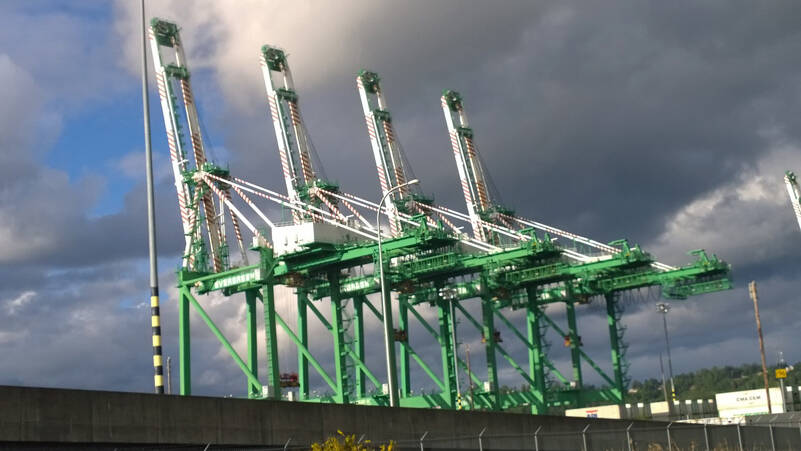By Morf Morford
Tacoma Daily Index
“We have shortages, a soaring cost of living, significant unemployment in some places and persisting labour gaps in others, taxes up, public spending up, borrowing up and child poverty on the rise.”
The statement above might sound familiar, but it’s not from The United States, it from Great Britain. You can see the full article here – https://www.independent.co.uk/voices/rishi-sunak-boris-johnson-manchester-wages-b1931859.html?.
You might think our US economy is a tangled mess will all kinds of stresses never seen or noticed before, you’d be correct, but our economy – especially our local Tacoma-Pierce County economy – is diverse enough, with income/employment streams as varied as the military, international trade, ample natural resources and a wide variety of high tech companies from Microsoft to Amazon (and many more).
But you don’t need to be a PhD in economics to see that our economic system, local, regional and global is experiencing stresses – and stress fractures – and opportunities – like we have never seen before.
Great Britain, of course has the monumental, self-imposed Brexit policy to largely blame for its problems.
Who would have imagined that withdrawing from the European Union would strangle the British economy? (Actually any 2nd grader with a pen and paper would have come to the all-too-obvious conclusion, but apparently none were available to assist politicians and voters at the time).
We, in the United States, don’t have Brexit, but we do have other, nearly as precarious conditions to deal with.
Labor shortages and shifts in pay scales are upending everything from mail service to restaurant hours and costs.
Consider just a few of these current, and all too visible market/employment trends:
I have seen companies offering $10,000 to $15,000 hiring bonuses.
Many fast food places and retailers who paid at or near minimum wage for decades are suddenly raising their pay scales.
Resignations, at everything from medical facilities to law enforcement are at record levels.
Our ports, and ports around the world, are backed up as never before- Los Angeles, in the first week of October, had nearly half a million 20-foot shipping containers – or about 12 million metric tons of goods – waiting in drift areas.
The port has 19 mega-container ships waiting to dock, the largest of which is carrying 16,022 20-foot shipping containers.
Many of today’s ships are larger, far larger, some double, even triple the size of ships a decade or so ago. They require more trucks, more trains and more warehouses to put the cargo.
And more qualified labor to move it all.
As in all areas of our labor force and economy, demographics rules over all.
AARP has told us for years that 10,000 of us are hitting retirement nationwide every day.
Factor in a worldwide pandemic, economic shake-outs in China, and increasingly variable weather expressing itself in intense hurricanes or fire seasons, and you have the recipe for the mother of all supply chain disruptions.
Consider something as simple as scheduling at our ports.
Asian ports, (and factories) for the most part, operate on a 24 hour, seven day a week schedule.
Ours don’t.
Most of our ports (including Los Angeles) operate on two shifts for longshore workers: 8 am to 4 pm and 6 pm to 3 am. Most ports are closed on Sundays. Overnight shifts and Saturdays are more expensive and rarely used.
But increasing hours of operation for port workers would not help much.
All that cargo has to go somewhere.
There will always be a backlog if truckers and warehouse operators have not similarly extended their hours.
It’s not optimal for truckers to pick up loads at night, especially when they’d have to find alternative places to store the goods when the warehouses are not open at night or on weekends.
And there’s no room for all the stuff.
Warehouses on the West Coast don’t have space for the goods.
About 98% of warehouses in Southern California’s logistics-heavy Inland Empire region are fully occupied, while the rest of the Western U.S. has a 3.6% vacancy rate.
A shortage of workers has made a difficult situation far worse.
Worker shortages, increasing prices, supply chain delays and crazy weather are expected to be dominant influences until at least early 2023.
And you can expect the unexpected when it comes to repercussions.
Some mail from the USA to Australia was suspended semi-indefinitely because of “carrier issues”. Whatever that means.
With factors like this at work, most of them years, if not decades in the making, (who in the shipping industry did not know that mega-container ships were coming?) who needs Brexit or even COVID to disrupt every economy, if not local business on the planet?
Mix in major financial dealings of the super wealthy like the recently exposed “Pandora papers” (or even the local version of pay exposure by Tacoma officials where we learn that average City of Tacoma pay was almost 50% more than the state average for the same position. You can see details here – https://opengovpay.com/employer/wa/city-of-tacoma/2020?).
Or you could factor in our increasing reliance on rare minerals (like lithium for electric car batteries) and you have a global economy ever more unstable, with more wealthy people hiding their wealth and more poor people visible in our headlines, at our borders or living on our streets.
There are more moving parts than ever before in our economy and the stakes are higher.
Not long ago such concerns were for the rich and powerful, but now thanks to our devices and our connections with each other, none of us is immune from inflation, variation of interest rates and employment trends.
Under previous formulas, higher pay meant increased specialization or productivity, but now pay is tied to “essential” work – which is as likely to be a long shore worker or truck driver as a dermatologist.
Welcome to the 21st Century version of the “Roaring twenties”.





